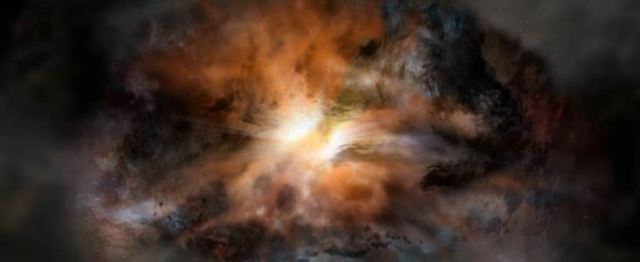Jan 19 2016
Quasars are distant galaxies that have supermassive black holes in their cores. The black holes are active and emit strong jets of radiation and particles. Quasars are highly energetic bodies and most of them shine bright, though a small fraction are known as Hot, Dust-Obscured Galaxies, or Hot DOGs - a rare type of Quasar. This unusual behavior is also found in the galaxy WISE J224607.57-052635.0, the most luminous galaxy in the universe.
 Artist impression of W2246-0526, a single galaxy glowing in infrared light as intensely as 350 trillion suns. It is so violently turbulent that it may eventually jettison its entire supply of star-forming gas, according to new observations with ALMA. (Credit: NRAO/AUI/NSF; Dana Berry / SkyWorks; ALMA (ESO/NAOJ/NRAO).
Artist impression of W2246-0526, a single galaxy glowing in infrared light as intensely as 350 trillion suns. It is so violently turbulent that it may eventually jettison its entire supply of star-forming gas, according to new observations with ALMA. (Credit: NRAO/AUI/NSF; Dana Berry / SkyWorks; ALMA (ESO/NAOJ/NRAO).
A research team from Universidad Diego Portales in Santiago, Chile, headed by Tanio Díaz-Santos, were the first to use the unique capabilities of ALMA to reveal the secrets of the quasar W2246-0526, and trace the movement of ionized carbon atoms that lie between its stars.
Large amounts of this interstellar material were found in an extremely turbulent and dynamic state, careening throughout the galaxy at around two million kilometres per hour.
Tanio Díaz-Santos, Universidad Diego Portales
Astronomers believe that this turbulent behavior found in the galaxy could be associated to its extreme luminosity. The W2246-0526 emits out light, roughly equivalent to the light emitted by 350 trillion Suns. A disc of superheated gas, spiraling on the galaxy’s supermassive black hole, provide this astonishing brightness to the quasar. The light emitted from the blazingly bright accretion disc, present in the center of the W2246-0526, cannot escape directly, but this light energy is re-emitted as infrared light once it is absorbed by the thick blanket of dust that surrounds it.
The entire galaxy is affected by the violent and direct impact of this infrared radiation. The region around the black hole displays a brightness of at least 100 times more than the rest of the galaxy collectively, and as a result intense radiation that is localized is released in to W2246-0526, causing the entire galaxy to experience tremendous pressure.
We suspected that this galaxy was in a transformative stage of its life because of the enormous amount of infrared energy.
Peter Eisenhardt, Project Scientist for WISE
“ALMA has now shown us that the raging furnace in this galaxy is making the pot boil over,” adds Roberto Assef, also from Universidad Diego Portales and leader of the ALMA observations.
If the turbulent conditions continue, the intense infrared radiation could boil away all the interstellar gas that is present in the galaxy. Galaxy evolution models that are based on the new data received from ALMA reveal that the galaxy is already ejecting the interstellar gas in all the directions.
If this pattern continues, it is possible that W2246 will eventually mature into a more traditional quasar. Only ALMA, with its unparalleled resolution, can allow us to see this object in high definition and fathom such an important episode in the life of this galaxy.
Manuel Aravena, Universidad Diego Portales